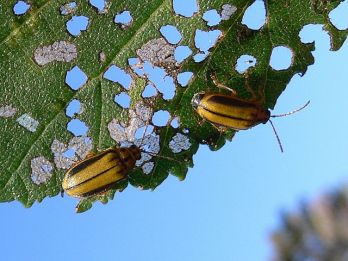Elm leaf beetle
Elm leaf beetle (Xanthogaleruca luteola) is a significant problem for elm trees.
It is not a declared pest under South Australia’s Plant Health Act 2009. This means that elm leaf beetle (ELB) is not notifiable, and Biosecurity SA will not apply control measures.
Local councils have been managing ELB for years and encourage households to do the same.
Background
The beetle exists in Europe and was introduced into the United States around 1834. ELB was discovered in Victoria in 1989 and was detected in South Australia in 2010.
ELB is now widespread across the Adelaide metropolitan area. They move easily along major traffic routes on cars that were parked near infected elm trees.
Impacts
ELB adults eat through elm leaves causing shot-holes. The larvae damage is called skeletonisation, where everything is eaten except for the leaf veins. Skeletonised leaves turn brown and drop prematurely.
Adults and larvae together can severely weaken mature elm trees and reduce their aesthetic and amenity value. Elms suffering from repeated ELB attack are more susceptible to other pests and disease.
A heavy infestation of ELB can completely defoliate an elm and affect growth of the tree. Although the tree will send out new leaves in the next season, it may die after a few years if ELB is not controlled.
Management
Management
Healthy elms are more likely to survive an ELB attack. Keep them watered in dry periods and apply slow-release fertiliser in late winter. Avoid compacting soil over the root zone.
Removing ELB early is important for tree recovery. Consider the below options, noting that only an arborist or pest control operator who has the required permits should apply these treatments.
Chemical controls
- Trunk injection – this is an effective and environmentally sound option for tree trunks less than 200mm diameter.
- Imidacloprid is injected directly into the trunk and the tree transports the chemical to the leaves where it kills the beetles.
- This insecticide remains effective for 2 to 3 years.
- Soil injection – this is detrimental to soil flora and fauna, but it can help elms of any trunk diameter.
- Imidacloprid can be injected into the soil with up to 100 L of water per tree. It is not recommended when soil moisture is low.
- Applications near creeks and rivers, or near food gardens, pose risks for human health. It may also kill earthworms and mycorrhiza.
- Canopy spraying – this method is impractical for large elm trees, but it may save young trees.
- Foliar sprays need to be applied annually.
- Chemical banding – this consists of wrapping the trunk with carbaryl insecticide.
- Bands must be applied high on the trunk away from children and pets.
Local councils in Adelaide may refer you to professionals who are licensed to provide soil and trunk injections.
Agricultural chemicals, including insecticides, must not be used for any purpose contrary to the label, unless authorised under appropriate legislation. Before using a chemical, read and adhere to the label instructions.
Learn about registered chemicals and current off-label permits through APVMA.
Non-chemical control
A safe, environmentally friendly way to break the beetle lifecycle involves trapping larvae that migrate down the trunk.
- Wrap adhesive tape around the trunk in a strip about 20cm wide, with the sticky side facing out. Horticultural glue can also be used.
- Timing is essential – bands must be applied before the larvae start to move between December and early February. This varies depending on the weather and requires close monitoring.
- Banding treatments may need to be reapplied several times each season if beetle numbers are high.
This method will not show results in the first year of application, but it should reduce beetle numbers and tree damage in subsequent years. Banding may not be effective against heavy infestations.
Biological control
- Natural enemies that parasitise ELB are being tested and evaluated, including Oomyzusgallerucae (a small wasp) and Erynniopsisantennata (a small fly).
- A spray made of the natural bacterium Bacillus thuringiensis subsp. tenebrionis has been trialled. This was found to be effective against ELB larvae and may become available commercially.
Identification
ELB are around 6mm long and yellowish to olive green, with black stripes. They lay tiny lemon-coloured eggs in clumps on the underside of leaves in spring.
The larvae are small and almost black. They grow through summer to a length of 12mm, appearing more like caterpillars.
Lifecycle
Around December to January, the larvae migrate down the tree trunk to pupate in the soil or in crevices on the lower trunk.
New beetles emerge after 1 or 2 weeks and carry on breeding in warm summers. Eggs hatch in 7 to 10 days.
With the onset of cooler autumn weather, ELB seek shelter in woodheaps, sheds, houses, and cars. They hibernate during winter and emerge in spring to feed on young elm leaves.


